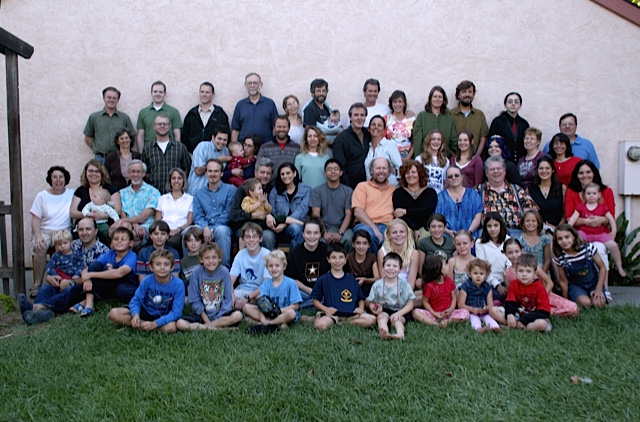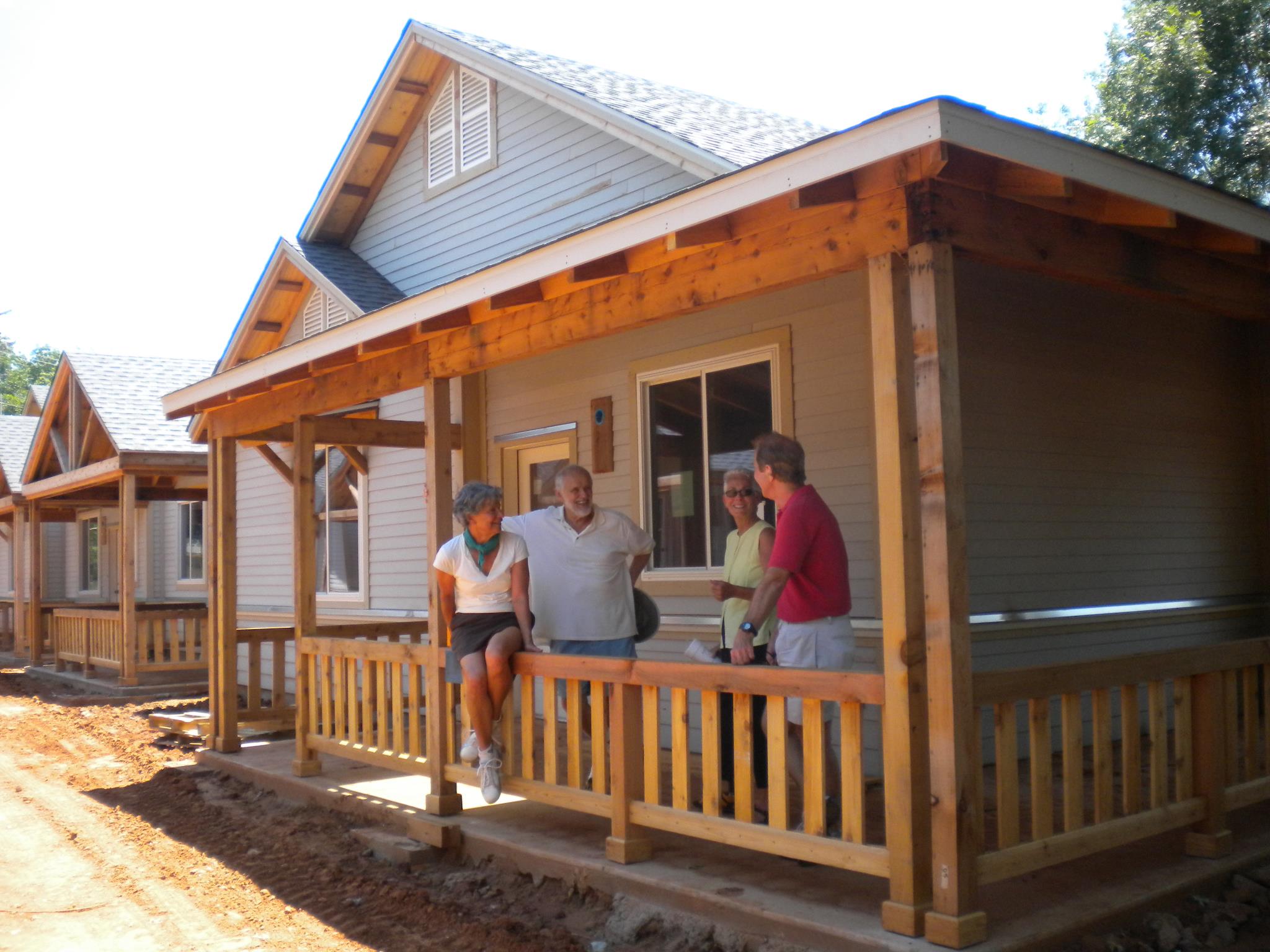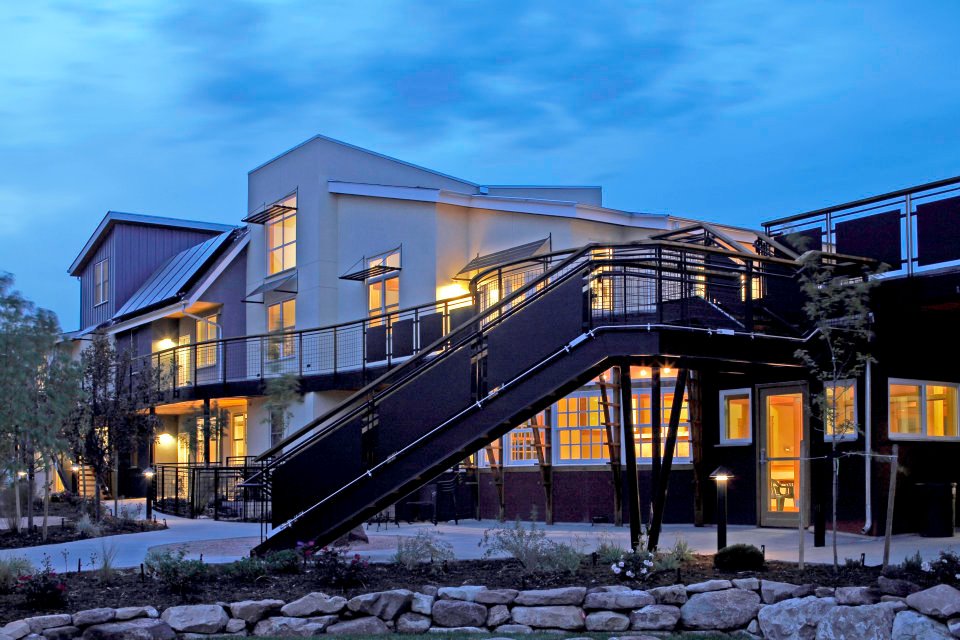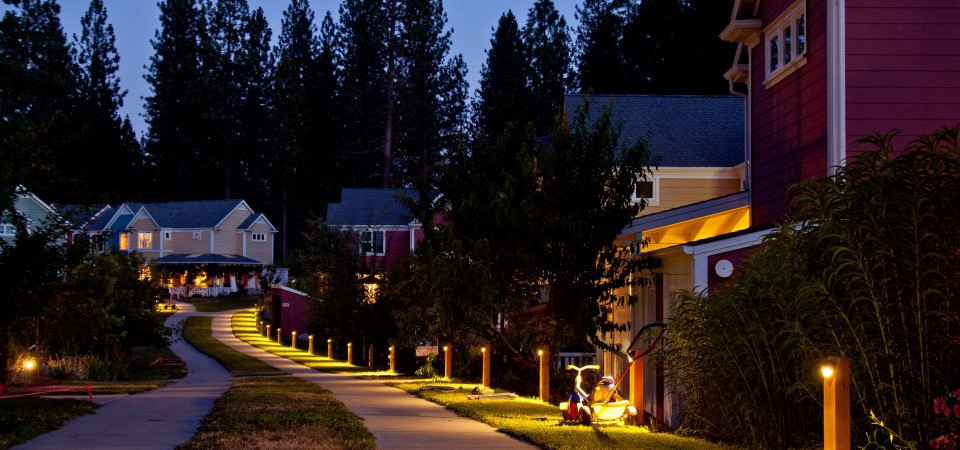Nevada City Cohousing, where Charles Durrett and his partner Katie McCamant live. (MDA via Facebook)
California architecture firm McCamant & Durrett Architects (MDA) call themselves "The Cohousing Company." The name is well-earned: founding partners (and spouses) Charles Durrett and Kathryn (Katie) Michiko McCamant introduced the concept of cohousing to the United States in 1988 in their book Cohousing: A Contemporary Approach to Housing Ourselves. The architects first became familiar with cohousing communities while studying at the Royal Academy of Art and Architecture at the University of Copenhagen in the early 1980s. They later returned to Denmark to further research cohousing (in Danish, bofællesskaber) before founding MDA in 1987.
MDA's and the United States' first cohousing project, Muir Commons in Davis, California recently celebrated its 25th anniversary. To date, MDA has completed a total of 51 projects in the United States and abroad. McCamant and Durrett, who live in a cohousing project they designed in Nevada City, California, continue to advocate for shared housing through their firm and other initiatives including McCamant's consultancy Cohousing Solutions.
Last month, I spoke by phone with Durrett about his experience as one of the nation's foremost cohousing advocates. We discussed his own journey of discovery, the successes and failures he has encountered along the way, and why cohousing remains relatively unknown in the United States.

Charles Durrett (right) works on a site plan for a cohousing group in Nashville. (MDA via Facebook)
I understand that you and Katie were first exposed to cohousing while studying in Copenhagen. How did that come about?
In 1980, when we were going to the University of Copenhagen, I had a 20 minute walk to the train station every morning. I lived in the suburbs. And on the way to the station every day I noticed that, as in the US, there was no life between the single-family houses, no life between apartment buildings, no life between the condominiums.
And yet there was one development that I walked by where nearly every day there were people talking to each other—standing on the sidewalk talking to each other, sitting on the picnic table talking to each other, going to and from this building [in which] apparently nobody lived, but everybody lived.
Finally one day, I stopped and asked, "What is going on here?" in my broken Danish. And this woman said, in her perfect English, that she and her husband wanted to make a neighborhood that made it easier to live lighter on the planet.
Actually, she was not very philosophical about it. She said, "We want to live in a high-functioning neighborhood." She and her husband had grown up in a high-functioning neighborhood, and they wanted their two children to grow up in a high-functioning neighborhood, where people knew each other, cared about each other, and supported each other at some basic level.
They weren't going to take it for granted, they weren't going to chance it—they weren't going to move into a neighborhood where they didn't know anybody and hope that it fell into place. They were going to take matters into their own hands and make such an animal themselves.
At that moment, I came to the conclusion that in fact this is a very conservative notion. Because she was simply very deliberately making something that she wasn't going to hope fell into place, but actually fell into place.
So that's how I was introduced to it, and later I introduced Katie to it, and we both fell in love with it.
And you later returned to Copenhagen to study cohousing?
Yes, a couple of years later we went back for 13 months.
What did you do during those 13 months?
Literally all we did was study cohousing, and how to make cohousing in the US. We went for six months, originally. We wanted to be able to do this for a living in the US. But after six months we realized that we couldn't ethically take a penny from anybody because we don't know enough yet, even from studying with the best in the world. So we stayed 13 months and then one day we said, "Okay I think we can take a penny from somebody and make this happen."
What made you want to import the model to the US?
I grew up in a small town of about 325 in the High Sierras. I knew what a functioning social setting looked like. It's very rare in America. In fact, that's been the hardest part about introducing cohousing [to the US]. If you talk about community, I find that nine out of 10 people don't know what you're talking about. They don't know that there are people who live nearby that you can depend on, for example. They don't know that there are people nearby that you have activities, and even rituals, with. It's almost an intellectual question for them. It's not obvious.
I was highly motivated to live in a place somewhat reminiscent of where people knew each other, cared about each other, and supported each other. I realized after college that I could move to the suburbs outside San Francisco like all of my colleagues had, and take the commuter train into the city every day. But when I visited them out there I had zero interest in living in such a place.
Also, we were highly motivated to have only one child, for ecological reasons. Many people have a second a child to keep the first one company—even in the city. Because in the city you can't let happen what we let our child—our child, at 18 months, with diapers drooping and pacifier in mouth, would go outside to see who else was around if we were being boring. And that's what we wanted Jessie to do. Living in cohousing, she has 37 brothers and sisters—or cousins, anyway. [Cohousing] it made it possible for us to live that goal.
So across the board—and there are many goals—we were motivated because it was personal. We wanted to live out our values: it wasn't just about what magazine we subscribe to and having a little-bit-better-than-average car. A fuel-efficient car makes no difference compared to all of the roads and highways that are set up so that you can see your acquaintances. We're social animals. But it's all a function of our car, and our phone, and our datebook. I wanted to live in a community where I didn't have to get in the car every time I wanted to say hello to somebody.

Residents of Muir Commons. (Courtesy MDA)
Let's talk about some of your firm's work. Your first cohousing project, Muir Commons, broke ground in Davis, California in 1989. Tell me about that experience.
Katie and I had just finished a book about cohousing [Cohousing: A Contemporary Approach to Housing Ourselves]. I was groping around, trying to figure out where we could initiate the first [cohousing project] in the US. And I just happened to go to this conference about environmental stuff, and I noticed that there were a lot of people there from Davis.
So I looked at Davis, and did basic grassroots organizing, where I went around to people and [booked a room for a presentation], advertised broadly—with fliers, that was the budget I had—and a bunch of people came. Somewhere between 60 and 80 people showed up. We were very happy with the enthusiastic response that we got on the very first night.
So obviously there was a pent-up demand, countrywide. Davis is chock-full of people who would like to live their values—they want to live beyond rhetoric. We had a planning commission there that was a sympathetic, and a developer who knew that if she was going to get her project built she needed to have a cohousing component, and we were off to the races.
We had 26 households from the very beginning. And one of the many things that's very impressive about that project is that 23 of the 26 households were first-time homebuyers, and we got them all into the project. Ten of them, I'm sure, bought a house at least ten years earlier than they would have [under other conditions]. But they were motivated by the whole cohousing thing, and found the money.
Are there any of your many other projects that you'd like to call out specifically?
Somebody just made us a Christmas present that was a medallion for the 51 projects we've finished. And I have to say my favorite one is going to be the next one, honestly. I'm very happy with how much we've learned from each project, and how our crew, Katie, everybody, has been able to stick with this approach to making housing.
It just gets better and better. We have two that are due on Friday, [January 15]. They are consequential projects: one of 28 houses, one of 30 houses. And they're state of the art, frankly.
They're so state of the art that—well, we've had interns from Denmark, come to work in our office for at least a few months to learn how to make cohousing. In my view, that's a big success.

Oakcreek Senior Cohousing in Stillwater, Oklahoma during construction. (MDA via Facebook)
Have you encountered barriers to your work?
Yes. The most common difficulty that groups have is finding a site. There've been plenty of groups that have gotten up to six, seven, ten households [together], and worked at it for a year, and never secured a site. That's unfortunate to me, because the next time that somebody in that town comes along and says, "Hey, we'll make cohousing," they'll be discouraged, and won't want to waste their time again. So that's a barrier, of sorts.
And, even here, in this little town of 3,000 [Nevada City, California] where we [live in] cohousing—Katie and I did our first presentation in town here in 1989. There was not a critical mass [to get] started. Six different cohousing groups over the next 13 years tried and failed to get started. Finally, Katie and I came here and looked for a site and found a site for them, and then proposed it to the various previous groups, and a few people came on board from each project.
Because we had a site, they were encouraged. And because Katie and I were doing it, and had such a track record, they were also encouraged. What happened previously was that there weren't enough people who had the entrepreneurial spirit to close on a site—and that makes sense. Not that many people have that much chutzpah. It only cost us $5,000, and [in the end] it didn't cost us anything because that was 100 percent refundable. If you haven't done anything like that before, it will scare 95 out of 100 people away.
One of the things that I'm encouraged about is that there are new entities—like there's Sage Cohousing now, a nonprofit in the US that wants to help seniors secure sites. I'm their vice-chair. And also Katie and I—our crews are pretty well armed, so we can jump on a plane and go to a town to find a site. Usually it takes us [only] a day or two, even after they've been struggling for a year or two.
Why, given the success you've had, hasn't cohousing gained traction more broadly?
That's a good question. And in a sense, that's a failure, I feel like, personally. As I mentioned, culturally, it's been generations now since most people have lived in a village-like setting. For many of us, we don't know the advantage.
We did a project in Tokyo a few years ago. The first meeting was 25 people. Tokyo has 27 million [residents], it's a serious city, it's a beehive. Yet it's surrounded by muras, which are very small villages of 100 to 200 people, 50 to 100 miles out of town. They just dot the landscape, practically equidistant from each other. [They are] high-functioning villages, for the most part.
Of the 25 people that came to the get-together, 19 of them were from muras—they had previously lived in high-functioning communities and now were for economic reasons, or for academic reasons, living in the big city. They knew the advantage of living in community; they wanted to live in community again.
That's a big hurdle in the US. We separated from our communities in Europe a long time ago, and many of us have been on the run ever since. Across the US, we talk a little bit about the small-town culture, but it's actually quite challenged, and a little bit strange, really.
I just wrote a book about Southern France called Revitalizing Our Small Towns. Of course, they have the same issue [we did]—agriculture is consolidating. But they've figured out how to save this small town. And they did it by making, for example, senior accommodations, long-term accommodations, on site so that these towns will stay occupied.
In this country, senior care has also become big business. We haven't eclipsed the possibility of seniors taking care of each other and themselves. But we've made it easy [for them to move elsewhere]—albeit expensive, $200,000 to $300,000 to move into these projects, and several thousand dollars a month.
The difficulty begins with knowing why you would want to do it. If you don't know why you would want to do it—especially in our culture, where we get eclipsed by so many other distractions. The average senior today is watching TV, unfortunately, over six hours a day. Some people would argue until cohousing gets on TV, we're [not going to be visible.] But it's more than that. It's more than getting on TV.
It's totally grassroots now. Far less than one percent of the population knows about cohousing. It's going to be people like you in the media who get it out there. And I'm just an architect. Given my druthers, I'd be sitting at home drawing waterproofing details.
[You write about the sharing economy.] In the context of cohousing, one of our rhetorics is: sharing is a big deal. [Where Katie and I live] we have 34 households, and we have one lawnmower, for example. We often share cars—we've had two shared cars over the years, and it makes it possible for nobody to own more than one car, even though there are lots of two-job families.
Otherwise I don't know how you share stuff, if you don't live right next door to each other. Do you, like, drive it to them? I mean, how do you share a lawnmower?
We make dinner for each other six nights a week—how do you do that without getting into a car? We share resources. We share time and skills. I have to make dinner on January 28. I will make all of the food and do all the shopping. That's shared resources, in that one person will go to the store, and buy food for 50 people instead of 34 households getting in their cars and going to the store independently.
It's really worth looking, when you're sharing stuff, [at] more than the thing, but life—sharing life itself. There's no better way to facilitate community than breaking bread together, for example. Sharing stories, and sharing trauma, and sharing happiness is part and parcel of the day. It's not constructed, it's not convoluted. Last night, dinner was at 7:00pm but I didn't leave the common house until after 9:00pm because I had to hear somebody's story about how she was going through a divorce. It was just important to share a shoulder.

Silver Sage Cohousing in Boulder, CO. (Ben Tremper/MDA via Facebook)
You and Katie have been living in cohousing as long as you've been building it. Has that experience changed your approach to designing cohousing?
It informs it. It informs it every day. In fact, when I'm working with a new project, I have to be careful not to say, too often, "Well, this is how we did it." Because my primary job is as an anthropologist, really. I have to figure out who this group is. I have to figure out how I'm going to make a physical experience meet who they are, and what they want.
Every once in a while I'll cut to the chase and say, "We have a ten-foot private front yard, and a twenty-foot backyard," and they say, "Okay, let's do that."
We've talked a lot about the intersection between cohousing and senior housing, which is an increasingly urgent need. But another big question is affordability. Can you speak to how the cohousing movement and affordability intersect?
We did a project in Berkeley, California. It was started by four single moms. At the time, the average house in Berkeley cost $500,000. [But] we had to make houses for $120,000. Of course, those women did not own houses previously, and when they come to the table and say this is what they can afford, than that's our job, to make a house for that amount.
We have a project very similar to that in Oklahoma that just took occupancy, and they could only afford $150,000. So we had to make brand-new houses for $150,000. Very challenging.
But the big intersection is that: somebody comes to the table, you can accommodate them. If they don't come to the table, they're probably not going to get accommodated. You can't sit around and wait for somebody else to make you affordable housing. You got to get in and do it yourself.
How would you suggest addressing the barriers to cohousing and expand the movement?
It seems that the expansion of every movement of consequence requires, more than anything, is organization and follow through. See the books The E-Myth and The Tipping Point. This was very much a part of the success in Denmark.
We are sharing our skills throughout America, as in books, and workshops (for example, our "Getting it Built" workshop). We are training more and more practitioners.
In the last 25 years, we have gone from one project to 150, plus lots of other legacy spill-over. Time magazine predicts 235 by the year 2020. I think that is probable, and who knows how many by 2050? I'm predicting thousands.









